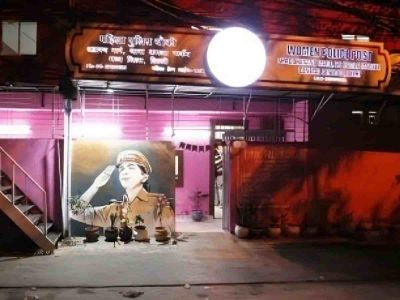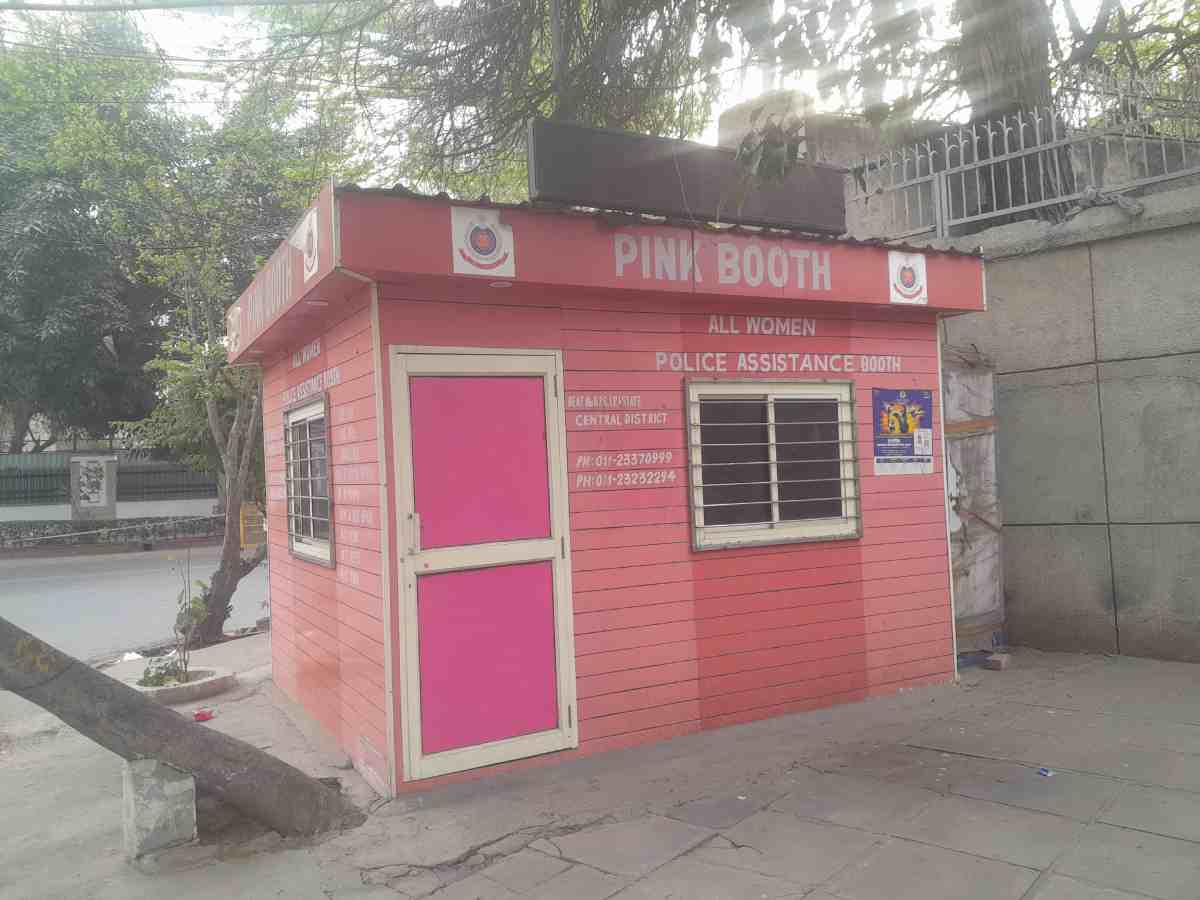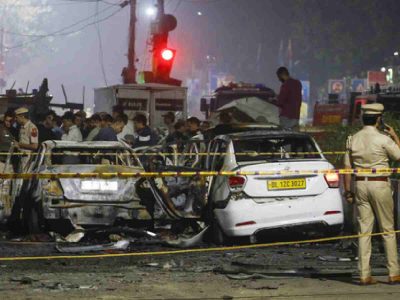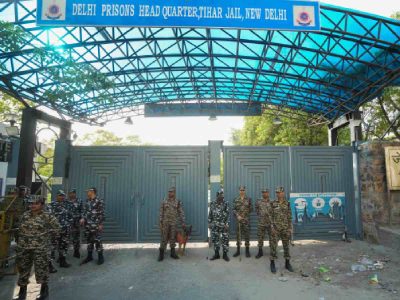Under the soft breeze of a February dusk, a female shopper, armed with a coterie of polythene bags, frantically knocked on a door in front of the Janpath market. After incessant knocking, she heaved a heavy sigh and set off to find a police station. Onlookers said that somebody had stolen her purse. Unfortunately, the solitary pink booth nearby was no longer operational. In fact, the booth at Janpath had also ceased to be pink, now decked in blue curtains, signifying its changed status.
Such is the state of most of Delhi Police’s pink and integrated police facilitation booths. According to Delhi Police, there are 135 pink booths and 115 integrated police facilitation booths across the national capital. However, most of these have fallen victim to bureaucratic inertia, unable to keep pace with the growing demands of Delhi’s population.
To assess the efficiency of these booths in maintaining law and order, Patriot conducted visits to several locations. We found that most booths were locked and had remained unmanned for extended periods. Others were staffed by male officers, defeating the purpose of the initiative.
The Pink Booth initiative: A fading promise
The Pink Booth Initiative was launched by Delhi Police in October 2021 to enhance women’s security and provide accessible police assistance in high-footfall areas such as schools, colleges, coaching complexes, and markets. These booths, staffed by female police officers, were designed to offer women a safe space to report harassment, seek assistance, and access police services without hesitation. They were also meant to provide self-defence training, helpline numbers, and mobile patrolling units.

The initiative was part of a broader effort to improve women’s safety in public spaces. The booths were supposed to be strategically located in areas where women and children were more likely to require assistance.
Similarly, on July 3, 2021, the first Integrated Police Facilitation Booth (IPFB) was set up at Mukherjee Nagar’s Kingsway Camp. These booths, designed to provide immediate assistance, were meant to handle women’s safety concerns, lost-and-found cases, and general inquiries.
Janpath: A resting place for police officers
While police officers sometimes claim the pink booth at Janpath is still functional, its original purpose has largely been forgotten. Over the past three years, barely anyone recalls why it was set up. More notably, officers now arrive only after their duty hours.
Presently, the booth has been repurposed as a resting space for officers. “We come here after our duty to relax. It is a break room for cops now, no longer a pink booth. However, if anybody needs help, we do rise to the task,” said a head constable patrolling the area. Due to the lack of police deployment, awareness about the booth’s existence has also diminished, according to traders in the area.
Kalkaji: A neglected outpost
The pink booth outside Deshbandhu College has remained shut for extended periods. According to students and residents, a male officer occasionally opens the booth. Though it is meant to cater to students from both Deshbandhu and Ramanujan colleges, it remains largely inaccessible.
“This booth has been closed for 3-4 months. Even though incidents of snatching occur here, women cops are never present,” said Prithish Banerjee, a student from Ramanujan College. Another student from Deshbandhu College confirmed this, stating the booth is “generally shut.”
Also Read: Understaffed and often unattended, Pink Booths fail to live up to the fanfare
Nearby vendors corroborated this claim, saying male officers occasionally occupy the booth while female officers are rarely seen. Vishikha Sharma, a student from Deshbandhu College, noted that female officers are only present during student union elections. “You will only see female cops during elections, but apart from those days, it’s unlikely. Many students aren’t even aware that the booth exists, and honestly, we can’t blame them,” she said.
Mata Sundri College for Women: A locked facility
The pink booth outside Mata Sundri College remains locked. Students noted that female officers were rarely seen, though some recalled instances where police helped in emergencies. The absence of an operational signboard left many unsure of when the booth was active.
With no officers present, students and vendors stated they had to rely on their own safety measures. Many suggested self-defence classes or community vigilance groups as more effective alternatives.
INA Market: Empty and neglected
An Integrated Facilitation Booth at Delhi Haat-INA Market was found vacant at 2 pm. Though a police jeep was parked nearby, it appeared unused for days.
Shankar, a local vendor, noted that while embassy officials frequently visit the market, policewomen are absent. A woman working at a nearby shop confirmed occasional police presence but said female officers were rarely seen. Employees of the National Human Rights Commission (NHRC) also reported the absence of female officers.
CGO Complex: A crucial location left unmanned
Near sensitive government offices, the Pink Booth at CGO Complex was found closed at 2 PM. With no officers in sight or operational signage, its absence raised significant concerns among locals and visitors. Government employees working nearby stated that while security in the area is generally high, the Pink Booth initiative has failed to provide consistent support for women.
Chanakyapuri: Lacking presence despite patrols
A pink booth near Jesus and Mary College (JMC) in Chanakyapuri was closed at 4 PM. Two male officers later arrived, but no female officers were present. Students of JMC and Maitreyi College said they felt safe due to frequent police patrols but noted the lack of awareness about the Pink Booths.
Despite the high-profile nature of the area, female students raised concerns about the booth’s effectiveness. “Even though we see police vehicles patrolling, it would be reassuring to have a fixed location where we know help is available if needed,” said a Maitreyi College student.
GB Road: The only success story
Unlike other areas, the Pink Booth at GB Road in Central Delhi has functioned efficiently for the past three years. Staffed entirely by women police personnel, it provides security and assistance to sex workers in the neighbourhood, many of whom have been trafficked from other states.

This booth has become a crucial resource, attracting police personnel from other states seeking to solve sex trafficking cases. Its success highlights what the initiative could achieve if properly staffed and managed.
The way forward
The widespread failure of pink booths across Delhi raises serious concerns about their effectiveness. With a severe shortage of personnel and a lack of operational oversight, these booths have largely failed to provide the safety net they were meant to create.
If the Delhi Police can ensure proper deployment and active management, these booths could still fulfil their intended purpose. Until then, they remain little more than locked rooms or resting spots for officers, offering little security for the women of the national capital.





